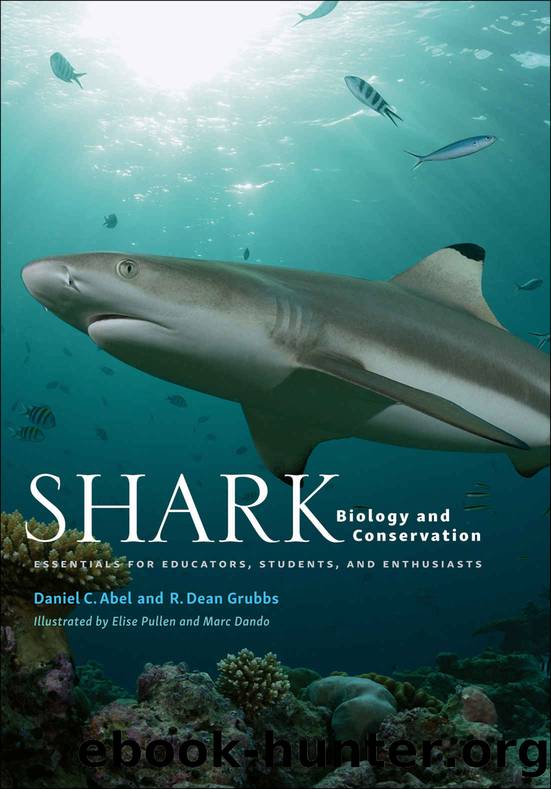Shark Biology and Conservation by Daniel C. Abel & R. Dean Grubbs

Author:Daniel C. Abel & R. Dean Grubbs [Abel, Daniel C.]
Language: eng
Format: azw3
Publisher: Johns Hopkins University Press
Published: 2020-08-31T16:00:00+00:00
Figure 7.8. (A) Diagram showing the heart of a shark in the pericardial space, which is extremely spacious and whose walls are connected to surrounding muscle and cartilage (with the exception of the transverse septum). (B) Ventral view of the heart (color) inside the pericardial space of a Blacknose Shark. (Photo by Joshua Bruni)
Three features of the elasmobranch pericardium distinguish it from that of other vertebrates. First, the pericardial walls adhere to surrounding tissue, mostly muscle. Because of this, the elasmobranch pericardium is frequently called semi-rigid or relatively non-compliant. Only the transverse septum (fig. 7.8A), a fibrous sheet that separates the pericardial cavity from the abdominal (peritoneal) cavity and is attached only along its edges to surrounding tissue, is free to move. Second, the pericardial space of elasmobranchs is capacious. Under physiological conditions (normal activity level), it contains around 2.0 ml-kg-1 (2 ml in a 1 kg shark) in the Horn Shark compared to about 0.3-0.8 ml-kg-1 in humans. Third, elasmobranchs have a duct that connects the pericardial and peritoneal spaces called the pericardio-peritoneal canal (PPC; fig. 7.9), which we included in Chapter 1 as an unrecognized distinguishing feature of this group. A connection between these two spaces is a feature in the early embryological development of all vertebrates, but persists only in elasmobranchs, some agnathans (jawless fish), and sturgeon. The significance of these three features to heart function is described below.
Let us see how these pieces work in unison to do what a cardiovascular system doesâpump the appropriate amount of blood to where it is needed precisely when it is needed.
We begin with the heart, specifically with a description of a mechanism so simple and elegant that it is included in every textbook in which heart function is discussed. Unfortunately, it is only partially accurate.9
Download
This site does not store any files on its server. We only index and link to content provided by other sites. Please contact the content providers to delete copyright contents if any and email us, we'll remove relevant links or contents immediately.
| Cell Biology | Developmental Biology |
| Entomology | Marine Biology |
| Microbiology | Molecular Biology |
| Biostatistics |
Sapiens: A Brief History of Humankind by Yuval Noah Harari(14252)
The Tidewater Tales by John Barth(12608)
Mastermind: How to Think Like Sherlock Holmes by Maria Konnikova(7227)
Do No Harm Stories of Life, Death and Brain Surgery by Henry Marsh(6891)
The Thirst by Nesbo Jo(6826)
Why We Sleep: Unlocking the Power of Sleep and Dreams by Matthew Walker(6618)
Life 3.0: Being Human in the Age of Artificial Intelligence by Tegmark Max(5474)
Sapiens by Yuval Noah Harari(5294)
The Longevity Diet by Valter Longo(5019)
The Body: A Guide for Occupants by Bill Bryson(4974)
The Rules Do Not Apply by Ariel Levy(4861)
The Immortal Life of Henrietta Lacks by Rebecca Skloot(4525)
Animal Frequency by Melissa Alvarez(4395)
Why We Sleep by Matthew Walker(4360)
The Hacking of the American Mind by Robert H. Lustig(4318)
Yoga Anatomy by Kaminoff Leslie(4306)
All Creatures Great and Small by James Herriot(4232)
Double Down (Diary of a Wimpy Kid Book 11) by Jeff Kinney(4207)
Barron's AP Biology by Goldberg M.S. Deborah T(4097)
